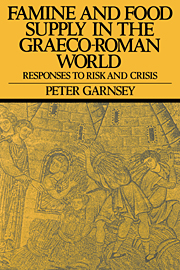Book contents
- Frontmatter
- Contents
- List of tables and figures
- Preface
- Abbreviations
- Maps
- PART I THE INCIDENCE AND SEVERITY OF FOOD CRISIS
- PART II SURVIVAL STRATEGIES
- 4 Subsistence and survival: the peasantry
- 5 Supply and distribution: urban communities
- PART III FOOD SUPPLY AND FOOD CRISIS IN ATHENS C. 600–322 BC
- PART IV FOOD SUPPLY AND FOOD CRISIS IN ROME C. 509 BC – AD 250
- CONCLUSION
- Bibliography
- Index
4 - Subsistence and survival: the peasantry
Published online by Cambridge University Press: 12 November 2009
- Frontmatter
- Contents
- List of tables and figures
- Preface
- Abbreviations
- Maps
- PART I THE INCIDENCE AND SEVERITY OF FOOD CRISIS
- PART II SURVIVAL STRATEGIES
- 4 Subsistence and survival: the peasantry
- 5 Supply and distribution: urban communities
- PART III FOOD SUPPLY AND FOOD CRISIS IN ATHENS C. 600–322 BC
- PART IV FOOD SUPPLY AND FOOD CRISIS IN ROME C. 509 BC – AD 250
- CONCLUSION
- Bibliography
- Index
Summary
INTRODUCTION
The Graeco-Roman world was a relatively highly urbanised society sustained for the most part by the labour of small farmers, owners or tenants. The pattern and extent of urbanisation, the condition of particular cities and their relation to one another were constantly changing. Individual peasant households survived, were extinguished, migrated and were subjected to varying degrees of exploitation. But the essential structure of Mediterranean society and the character of its economic base remained relatively stable through the period of classical antiquity.
In this chapter and the next, I consider the problem of the food supply from the viewpoints of subsistence or near-subsistence producers and urban residents. The survival of the peasantry depended upon their success in following a low-risk production strategy, and in establishing and making the most of social and economic links with their equals and superiors in society.
As for cities, there was little regulation of the food supply by local governments. Fourth-century BC Athens and late Republican and Imperial Rome were exceptional in this respect. In most states the civic authorities intervened only in times of crisis, and their involvement lasted only as long as the emergency itself. Moreover, government or other public response to food crisis was rarely radical. Property redistribution was not entertained as a possibility, and such permanent institutions as were devised for dealing with food crisis were rudimentary. It was left very much to members of the elite acting in a private capacity to protect ordinary citizens against a breakdown of the food supply system.
- Type
- Chapter
- Information
- Famine and Food Supply in the Graeco-Roman WorldResponses to Risk and Crisis, pp. 43 - 68Publisher: Cambridge University PressPrint publication year: 1988



